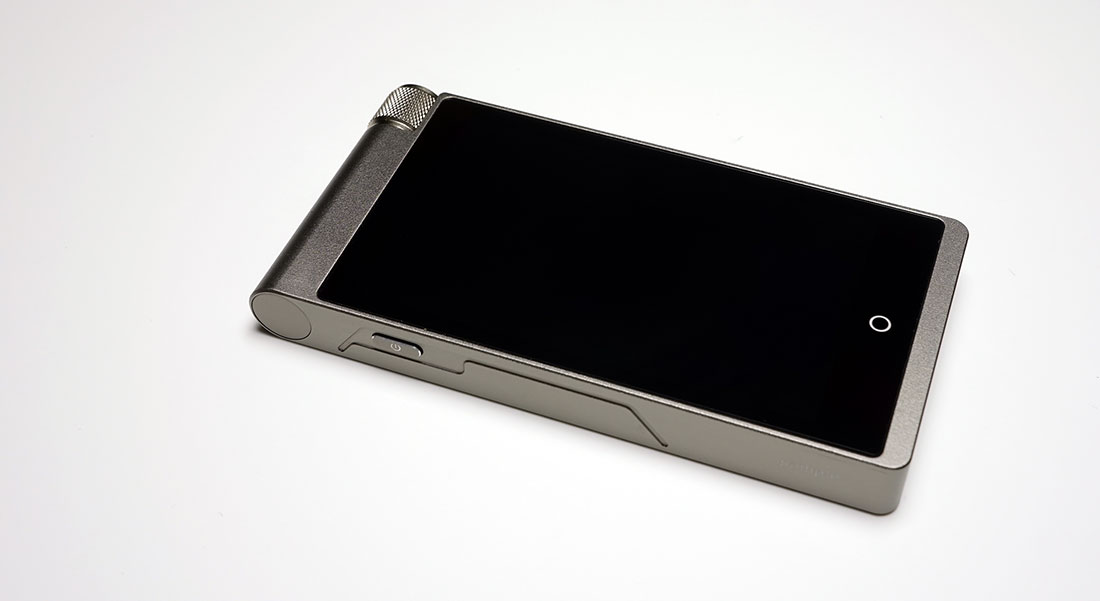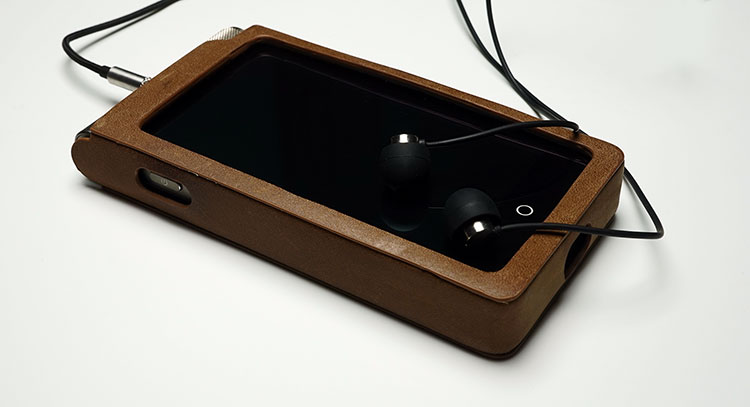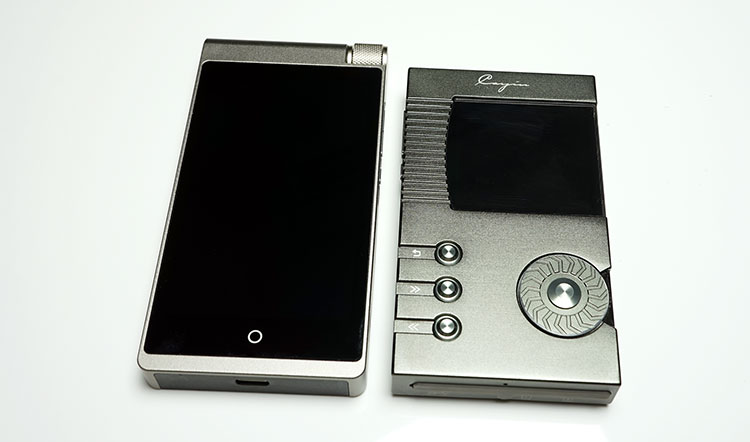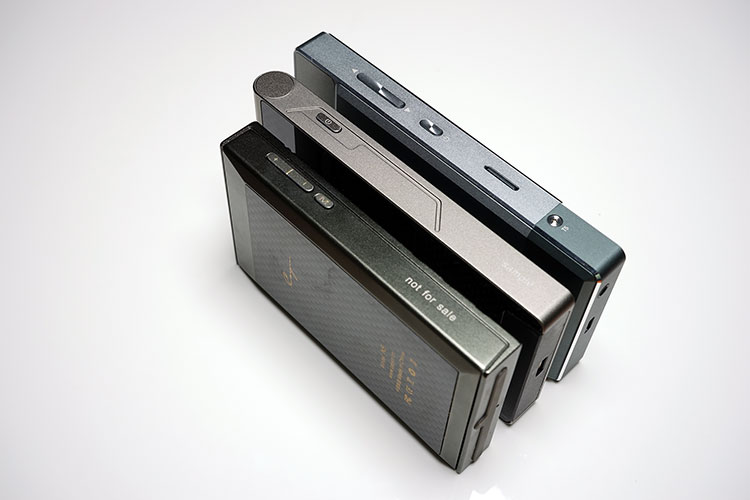Sound Impressions
Summary
Since both have a similar DAC it is perhaps unsurprising to hear that the i5 follows a similar warm but detailed tonal presentation of the N5.
However, there are some important tweaks that give each a slightly different experience and I am putting that down to the upgraded processor and opamp tweaks Cayin introduced to the i5 at the final stages of development.
Smoothing the Edges
Both the N5 and the i5 are full sounding musical DAPs. Both have planted low ends, a rich midrange with an enhanced vocal presence, and a relaxed treble performance.
However, on the i5 that sharp edge in the attack of the N5 is now gone. In its place are a slightly softer and smoother attack, a more spacious soundstage and a slightly longer low-end decay with better sub-bass presence.
Overall, the i5 sounds a bit more laid back than the N5 but carries no less texture or detail. The greater the processing resource requirement, the higher the decoding needs (DSD) then the better the i5 performs in terms of resolution compared to the N5.
That last statement is incredibly important because it could so easily have been a syrupy lush-sounding DAP with a frustrating level of veil by pulling back on that sharp edge on the N5 too much.
Instead, the i5 sounds much more natural now than the N5 and flows a lot more smoothly, particularly in its lower treble response, leaving the N5 as the punchier, energetic and more aggressive sounding of the two.
Tonal Positioning
That still makes the N6 the analytical king of the Cayin line up and I am sure Cayin will be just fine with that (for now). It still has the reference neutral yet natural sound, the flatter or more linear experience than either of the N series DAPs.
However, the i5, for me, just edges ahead a little of the N5 and a touch closer to the N6 in terms of refinement and resolution, particularly at higher decoding rates.
Synergy
Ultra-Efficiency
There has been a compromise of sorts in the level of efficiency in the i5. Yes, balanced is no longer available and that was one of the slight issues people had with the N5’s output now eliminated but even so the unbalanced output of the i5 is not totally silent for some ultra-efficient IEMs.
IEMs such as the Shure SE846 (hiss), and the Campfire Audio BA range such as Andromeda and Jupiter show a minor degree of background noise using the unbalanced output of the i5 as did some of my highest rated CIEMs such as the 64 Audio A12 (16 ohms 117dB) and the VE6XC (20 ohms 122dB).
Medium Efficiency
However, it is not a clean sweep, and I think the issue may be reserved to a few notoriously sensitive earphones. IEMs such as the Oriveti Primacy (11 ohms, 107dB) and the Campfire Orion (14 ohms, 113dB) which I noted as being fairly sensitive in previous reviews are fairly quiet with zero hiss and low noise on the i5.
Dynamic IEMs such as the Sennheiser IE 800 (16 ohms, 125dB) and the CA Lyra did perform better with a clean blacker background than BA CIEMs such as the A12 which did have a touch more noise but again no horrible artifacts or hiss such as you would find on the Shozy Alien Silver pairing.
IEMs such as the Fidue A91 Sirius (20 ohms, 113dB) are completely silent in low gain mode and run quite happily around 30 digital steps on the volume control of the i5.
Volume
Pretty much all IEMs tested ranged between 25 and 35 digital steps in low gain with the Andromeda being the most sensitive to something like the RHA T20 and the oBravo ERIB-5A pushing up to nearly 40 steps.
One thing I did note was the pot itself had a tiny bit of noise when pushing it up fast say from 25 to 35 steps. This happened in both the digital control and analog pot control so it may well be a byproduct of efficiency given it is more prevalent on more sensitive IEMs and much lower to non-existent on the RHA T20 and the oBravo.
Power
Flagships
The i5 amping is not QP1R levels but it does go pretty loud under a fair amount of load without clipping or unacceptable levels of distortion. Noise control is excellent and though it won’t sound the best with heavy-duty cans such as the HD800, LCD-2, or the Ether C it will go plenty loud on these if needed.
Dynamic Headphones
Best performing headphones with the i5 tended to be relatively lively headphones with excellent midranges and a responsive low end and sit around 32ohms but dynamic headphones such as the 250 ohm DT1770 PRO sounded good also with a snappy and deep bass response.
Perhaps my favorite tonal dynamic pairing was the Meze 99 Classics. Easily enough power and output voltage to drive this 32Ω small circumaural headphone to satisfy levels with a great sense of PRaT, engaging and vivid presentation, and a very natural but dynamic sound. Nothing peaky, too sharp or bloated with this pairing.
Modern Planars
The i5 had zero driving issues with modern efficient planar headphones such as the Oppo PM-3 and the Hifiman HE400s in either low gain (around 35-38 steps) or high gain (around 33-35 steps).
The PM-3 had a bit more punch and vibrancy with the i5 on high gain and a touch easier to drive than the HE400s (38-40 steps on high gain) but it was the HE400s that sounded that bit more expansive and engaging though at the cost of a little loss in body and weight compared to the PM-3.
Less efficient planars such as the Fostex T50RP MK3 (Talos Edition) took up a fair bit more juice and sat around 50-55 steps in high gain on the i5 but didn’t feel compressed or shrill instead offering a warm to a neutral presentation, good staging and excellent levels of detail.
Ideally, once you start delving deeper into the high-end or older less efficient headphones I would grab the OTG to coaxial cable and run the i5 from a Hugo just to give it a bit more power and weight for something like the Ether.
Select Comparisons
Cayin N5
Positioning
It is the only non-touch-based comparison in the round-up simply because the i5 has drawn aspects of the functionality, modules, and software features originally present in the N5.
It is also still in the product lineup and in comparison, would be considered the baseline DAP option if you want to get into Cayin DAPs. The N6 is still their flagship so the i5, regardless of its wow factor, is just behind the N6 in terms of pure audio quality as a reference DAP.
Technicalities
Outside of audio quality, the N5 is light years behind the i5 in terms of wireless connectivity and software management. It also looks old, but in return it looks incredibly solid, perhaps more robust than the i5.
Port management is also simpler on the i5 with a single USB-C for just about everything whereas the N5 uses USB 3.0 and dual memory slots (one slight advantage over the i5). Of course, that rubber flap on the N5 ports is not to everyone’s tastes.
Balanced
The big benefit of the N5 over the i5 is the balanced 2.5mm TRSS output jack on the top panel. That is a feature the i5 does not have sadly and for some who enjoyed the benefits of the balanced output may want to consider the upgrade value if this is their top priority.
Tonal
Tonally the two DAPs have a very similar presentation in that they are both musical and err on the warm side. Both have a relaxed top end and possess an excellent low-end body with a good slam, though the N5 is a little bit more dynamic and punchy in that respect.
The key difference for me is in the mids and lower treble where the N5 has a sharper attack that is a little more fatiguing than the slightly more laid-back and natural-sounding attack of the i5.
You do not always hear it, but when percussion and higher-pitched vocals kick in, particularly on bright tracks it can get just a little sharp. EDM doesn’t suffer but once you throw on rock or synth-heavy work the difference is more noticeable.
The i5 is not exactly a super syrupy affair mind you, it still has an articulate treble performance but this time, the sharpness of the N5 is not present making it a more pleasant and relaxed listening experience.
FiiO X7
Platform
The X7 has also opted for Android 4.4 as its core platform in the touch-sensitive X7 and is priced around $100-$200 higher depending if you select an amp module with the stock player or not.
The X7 Android experience, however, is the typical vanilla smartphone type of Android experience with the ability to download most apps from the Google Play market in the usual fashion as well as a more prominent apps drawer.
DAP audio playback is in the Fiio stock app but you can also download HiBy Music on the X7 if you wish and skin it to look very similar in functionality to the i5 (which is usually what I end up doing using the X7).
Functionality
On the functionality side, the X7 sports a huge ES9018 DAC chip inside, not the mobile version but the big daddy you normally find in desktops.
Compared to the AKM AK4490EQ DAC chip in the i5 it is more expensive but should, in theory, extract more resolution and err more to a neutral presentation than the colored AK chip. That rings largely true but it’s also colored by the amp module of choice for the X7.
AM1/2 & 5
Compared to the AM1 the i5 handily outpaces the flatter less engaging neutral sound of this IEM module sounding far more dynamic, and punchy with a thicker more satisfying note.
The AM2 and AM5 are close in tonality to the i5 with a more musical and aggressive low end and better body in the mids though the i5 still sounds a touch warmer and richer by comparison.
AM3
The AM3 offers an unbalanced mode that sounds a touch more neutral and smoother, less dynamic than the i5. If you want to dial down the bass weight a little, then the AM3 unbalanced will do that for you and give you a little bit more space and separation in the midrange.
Switch the X7 AM3 to balanced and impact, bass weight and dynamics increase substantially and pull ahead of the i5 with a slightly cleaner more detailed midrange and a bit more sparkle in its treble response.
The only downside of the AM3 balanced is a higher noise floor for IEMs which the i5 (and X7 unbalanced for that matter) do not suffer from.
Opus#1
Platform
The Opus#1 is another touchscreen mid-fi DAP priced at $599 and also with a skinned 4.4 Android platform but unlike the i5 and X7, it is a very restricted walled garden with no access to 3rd party apps and a very linear “in and out” navigation system.
The i5 software feels far more expansive and has a better setup for user navigation with more features such as Wifi and BT and options within 1-2 clicks than the Opus#1 software.
Technicalities
Build wise the Opus#1 uses a solid but cheaper hard plastic over the premium feel of the i5. The Opus#1 does have a functional DAC feature at the time of writing which the i5 has yet to fully implement as well as the fact it sports dual memory slots and a balanced output which is also lacking on the i5.
The i5 though does have a vastly superior and more aesthetically pleasing IPS 4″ screen over the more basic 4-inch TFT Wide Touch Display (480 x 800) of the Opus#1. Both are fairly responsive though with good capacitive performance and the speed overall between them is about equal.
Tonality
Tonally the Opus#1 is also a natural sounding to neutral DAP but is a little flatter sounding with less bass slam than the i5. The Opus#1 has a more linear response in general over the more musical and weighted sounding i5.
Vocals on the i5 are more forward than the Opus#1 with a bit more depth in its staging than the Opus#1 which tends to offer a wider and taller presentation.
In balanced mode, the Opus#1 yields a bit more bass body but still sounds flatter and less dynamic than the i5. Both have excellent detail and to be fair the micro detail on the Opus#1 is excellent and possibly has the edge in that respect over the i5 but I just find myself slightly detached from the Opus#1
Sony ZX2
Platform
The $1000 ZX2, much like the FiiO X7 is a lightly skinned Android platform in the traditional smartphone style with a fully-fledged apps drawer and widget-driven system.
The Walkman theme does offer a nice after-touch with a tailored music and video apps system built on a slightly earlier Android 4.2.
It is not as snappy though as the X7 or the Cayin i5 Hiby Music Android platform despite offering 1Gb of RAM on an earlier Android version and it doesn’t feel as integrated as the i5 experience. You can elect to use Hiby Music of course on the ZX2 which does help to improve its usability.
Technicalities
Like the i5 it does have a complete set of connectivity options including WiFi, BT, and DLNA as well as microSD but the Sony does have a very large 128Gb onboard storage compared to the 32Gb on offer by the i5.
The biggest drawback of the Sony is the connection modality which is entirely Sony proprietary and annoyingly expensive to tool up in terms of digital audio cables compared to the cheaper and more universal USB-C.
It has always been a Sony thing though so whilst the ZX2 build quality is superior and better machined than the i5, the insular thinking just irks the heck out of me for cables. On a final note though I will say the Sony battery life slays the i5 with a rated 33 hours on paper which is 3 times as much as the i5.
Tonality
Whilst both have a low-end emphasis the general tonality of the ZX2 can be considered a bit more neutral than the i5 with a slightly cleaner attack and tighter low-end decay. In contrast, the elevated low end of the i5 is warmer with a longer decay and a bit softer sounding in comparison.
Guitar work and in general the ZX2 midrange leans to the more precise and detailed than to the rich and musical. The treble on the ZX2 also has a touch more articulation and is slightly more forward-sounding. Vocals on the i5 in general sound more relaxed with a thicker texture than the ZX2’s slightly sharper response.
Our Verdict
After testing and listening to the i5 for close to 2 months now I can honestly say for $499 this is probably the best all-round DAP in the market today. It is also a thoroughly modern DAP with a rock-solid touch-sensitive Android platform and a very likable UI in partnership with HiBy Music.
Connectivity is everywhere from WiFI to BT, from DropBox to LAN, and from Spotify to Google Play. There is plenty of room for expansion locally with up to 200Gb microSD, OTG for even more, and 32GB onboard.
It also sounds superb, smooth, and very musical. It’s like the N5 corrected for me. Gone is the sharp attack, in comes the natural slightly more laid-back sound but up goes the resolution.
DSD sounds fabulous on the i5 by the way. Cayin has done an excellent job keeping everything as low as possible distortion wise whilst keeping the power more than adequate for a wide variety of IEMS and headphones.
There are some quirks. Gone is the balanced 2.5mm TRSS output of the N5 sadly. It does have a level of noise for the most inefficient IEMs out there with some offering blacker and quieter backgrounds than others and the pot is not completely quiet for me with rapid movement (again could be just my unit) up or down in a 5-10 step parameter.
Genre boxing could be a bit more expansive on the software with the section “Other” not so tucked away as to be almost out of sight and lastly the lovely looking leather case could be a bit tighter as I feel sure the poor i5 will go into freefall one of these days if held in the wrong way.
All being said this is an ambitious project and Cayin has pulled it off in my opinion. It could so easily have fallen into a cul de sac of bugs and afterthoughts (think DX100) but just about every angle is covered. It feels mature and even though technically the N6 is still the flagship it will be the i5 that gets the popular vote and the attention.
Cayin i5 Technical Specifications
Headphone Output
- Power rating: 190mW+190mw (@32Ω)
- Frequency Response: 20-20kHz(±0.2dB,Fs=192kHz) 5-50kHz(±1dB,Fs=192kHz)
- THD+N: 0.006% (1kHz,Fs=44.1kHz,20Hz-20kHz,A-Weighted)
- Dynamic Range: 108dB (20Hz-20kHz, A-Weighted)
- SNR: 108dB (20Hz-20kHz, A-Weighted)
- Output Impedance:≤1Ω
Line Out
- Output Level: 1.2V (@10kΩ)
- Frequency Response: 20-20kHz (±0.2dB,Fs=192kHz) 5-50kHz (±1dB,Fs=192kHz)
- THD+N: 0.005% (1kHz,Fs=44.1kHz,20Hz-20kHz,A-Weighted)
- Dynamic Range: 108dB(20Hz-20kHz,A-Weighted)
- SNR: 108dB(20Hz-20kHz,A-Weighted)
Battery
- Capacity: 4800mAh 3.8V Lithium-ion polymer
- Lifetime: 10 HRS
- Charging time: 4.5 HRS (with 2A Charger, not provided)
- Charging Current:≤1500mA when charge with 2A Charger,≤500mA when charge with computer USB port
Music Format
- DSF: Native hardware decodes DSD64 and DSD128
- DFF: Native hardware decodes DSD64 and DSD128
- SACD-ISO: Native hardware decodes DSD64 and DSD128
- APE: Support16-32bits, Fast/Normal /High/Extra High compression level)
- FLAC: Up to 384 kHz/32bit
- WAV: Up to 384 kHz/32bit
- AIFF: Up to 384 kHz/32bit
- ALAC: Up to 384 kHz/32bit
- WMA: Up to 96 kHz/24bit
- WMA Lossless: Up to 96 kHz/24bit
- MP2/MP3: Up to 48 kHz/16bit
- AAC: Up to 48 kHz/16bit
- OGG: Up to 48 kHz/16bit
USB decoding (DAC)
- USB Mode: A synchronized USB Audio 2.0 Class
- DSD: Up to DSD128
- PCM: Up to 384kHz/32Bit
- Windows: Suppor (Driver required)
- MAC Osx: Support
- iOS: Not Support
- Android: Not Support
Package
- Cayin i5 Music Player
- USB Cable
- Cloth Carrying bag






